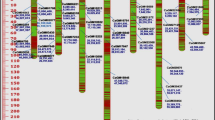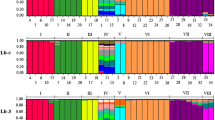Abstract
Paucity of polymorphic molecular markers in chickpea (Cicer arietinum L.) has been a major limitation in the improvement of this important legume. Hence, in an attempt to develop sequence-tagged microsatellite sites (STMS) markers from chickpea, a microsatellite enriched library from the C. arietinum cv. Pusa362 nuclear genome was constructed for the identification of (CA/GT) n and (CT/GA) n microsatellite motifs. A total of 92 new microsatellites were identified, of which 74 functional STMS primer pairs were developed. These markers were validated using 9 chickpea and one C. reticulatum accession. Of the STMS markers developed, 25 polymorphic markers were used to analyze the intraspecific genetic diversity within 36 geographically diverse chickpea accessions. The 25 primer pairs amplified single loci producing a minimum of 2 and maximum of 11 alleles. A total of 159 alleles were detected with an average of 6.4 alleles per locus. The observed and expected heterozygosity values averaged 0.32 (0.08–0.91) and 0.74 (0.23–0.89) respectively. The UPGMA based dendrogram was able to distinguish all the accessions except two accessions from Afghanistan establishing that microsatellites could successfully detect intraspecific genetic diversity in chickpea. Further, cloning and sequencing of size variant alleles at two microsatellite loci revealed that the variable numbers of AG repeats in different alleles were the major source of polymorphism. Point mutations were found to occur both within and immediately upstream of the long tracts of perfect repeats, thereby bringing about a conversion of perfect motifs into imperfect or compound motifs. Such events possibly occurred in order to limit the expansion of microsatellites and also lead to the birth of new microsatellites. The microsatellite markers developed in this study will be useful for genetic diversity analysis, linkage map construction as well as for depicting intraspecific microsatellite evolution.



Similar content being viewed by others
References
Abbo S, Shtienberg D, Lichtenzveig J, Lev-Yadun S, Gopher A (2003) The chickpea, summer cropping, and a new model for pulse domestication in the ancient near east. Q Rev Biol 78:435–448
Ahmad F, Gaur PM, Slinkard AE (1992) Isozyme polymorphism and phylogenetic interpretations in the genus Cicer L. Theor Appl Genet 83:620–627
Akagi H, Yokozaki Y, Inagaki A, Fujimura T (1998) Origin and evolution of twin microsatellites in the genus Oryza. Heredity 81:187–197
Amos W, Sawcer SJ, Feakes W, Rubinszstein DC (1996) Microsatellite show mutational bias and heterozygote instability. Nat Genet 13:390–391
Billotte N, Lagoda PJL, Risterucci AM, Baurens FC (1999) Microsatellite-enriched libraries: applied methodology for the development of SSR markers in tropical crops. Fruits 54:277–288
Cho YG, Ishii T, Temnykh S, Chen X, Lipovich L, McCouch SR, Park WD, Ayres N, Cartinhour S (2000) Diversity of microsatellite derived from genomic libraries and GenBank sequences in rice (Oryza sativa L.). Theor Appl Genet 100:713–722
Choudhary S, Sethy NK, Shokeen B, Bhatia S (2006) Development of sequence-tagged microsatellite site markers for chickpea (Cicer arietinum L.). Mol Ecol Notes 6:93–95
Chowdhury MA, Vandenberg V, Warkentin T (2002) Cultivar identification and genetic relationship among selected breeding lines and cultivars in chickpea (Cicer arietinum L.). Euphytica 127:317–325
Croser JS, Ahmad F, Clarke HJ, Siddique KHM (2003) Utilisation of wild Cicer in chickpea improvement—progress, constraints and prospects. Aust J Agri Res 54:429–444
Doyle JJ, Doyle JL (1987) A rapid DNA isolation procedure for small quantities of fresh leaf tissue. Phytochem Bull 19:11–15
Edwards KJ, Backer JHA, Daly A, Jones C, Karp A (1996) Microsatellite libraries enriched for several microsatellite sequences in plants. BioTechniques 20:758–760
Ferguson ME, Burow MD, Schulze SR, Bramel PJ, Paterson AH, Kresovich S, Mitchell S (2004) Microsatellite identification and characterization in peanut. Theor Appl Genet 108:1064–1070
Flandez-Galvez H, Ford R, Pang EC, Taylor PW (2003) An intraspecific linkage map of the chickpea (Cicer arietinum L.) genome based on sequence tagged microsatellite site and resistance gene analog markers. Theor Appl Genet. 106:1447–1456
Gaitan-Solis E, Duque MC, Edwards KJ, Tohme (2002) Microsatellite repeats in common bean (Phaseolus vulgaris): isolation, characterization, and cross-species amplification in Phaseolus ssp. Crop Sci 42:2128–2136
Gupta PK, Varshney RK (2000) The development and use of microsatellite markers for genetic analysis and plant breeding with emphasis on bread wheat. Euphytica 113:163–185
Harr B, Schlötterer C (2000) Long microsatellite alleles in Drosophila melanogaster have a downward mutation bias and short persistence times, which cause their genome-wide underrepresentation. Genetics 155:1213–1220
He C, Poysa V, Yu K (2003) Development and characterization of simple sequence repeat (SSR) markers and their use in determining relationships among Lycopersicon esculentum cultivars. Theor Appl Genet 106:363–373
Huttel B, Winter P, Weising K, Choumane W, Weigand F, Kahl G (1999) Sequence-tagged microsatellite site markers for chickpea (Cicer arietinum L.). Genome 42:210–217
Iruela M, Rubio J, Cubero JI, Gil J, Millan T (2002) Phylogenetic analysis in the genus Cicer and cultivated chickpea using RAPD and ISSR markers. Theor Appl Genet 104:643–651
Jin L, Macaubas C, Hallmayer J, Kimura A, Mignot E (1996) Mutation rate varies among alleles at a microsatellite locus: phylogenetic evidence. Proc Natl Acad Sci USA 93:15285–15288
Kruglyak S, Durrett RT, Schug M, Aquadro CF (1998) Equilibrium distributions of microsatellite repeat length resulting from a balance between slippage events and point mutations. Proc Natl Acad Sci USA 95:10774–10778
Labdi M, Robertson LD, Singh KB, Charrier A (1996) Genetic diversity and phylogenetic relationships among the annual Cicer species as revealed by isozyme polymorphism. Euphytica 88:181–188
Lichtenzveig J, Scheuring C, Dodge J, Abbo S, Zhang HB (2005) Construction of BAC and BIBAC libraries and their applications for generation of SSR markers for genome analysis of chickpea, Cicer arietinum L. Theor Appl Genet 110:492–510
Lowe AJ, Moule C, Trick M, Edwards KJ (2004) Efficient large-scale development of microsatellites for marker and mapping applications in Brassica crop species. Theor Appl Genet 108:1103–1112
Maguire TL, Edwards KJ, Saenger P, Henry R (2000) Characterisation and analysis of microsatellite loci in a mangrove species, Avicennia marina (Forsk.) Vierh. (Avicenniaceae). Theor Appl Genet 101:279–285
Malmberg R, Messing J, Sussex I (1985) Molecular biology of plants: a laboratory course manual, Cold Spring Harbor Laboratory, Cold Spring Harbor
Matsuoka Y, Mitchell SE, Kresovich S, Goodman M, Doebley J (2002) Microsatellites in Zea—variability, patterns of mutations, and uses for evolutionary studies. Theor Appl Genet 104:436–450
Messier W, Li SH, Stewart CB (1996) The birth of microsatellites. Nature 381:483
Metzgar D, Liu L, Hansen C, Dybvig K, Willis C (2002) Domain-level differences in microsatellite distribution and content result from different relative rates of insertion and deletion mutations. Genome Res 12:408–413
Peakall R, Gilmore S, Keys W, Morgante M, Rafalski A (1998) Cross-species amplification of soybean (Glycine max) simple sequence repeats (SSRs) within genus and other legume Genera: implications of the transferability of SSRs in plants. Mol Biol Evol 15:1275–1287
Pfaff T, Kahl G (2003) Mapping of gene-specific markers on the genetic map of chickpea (Cicer arietinum L.). Mol Genet Genom 269:243–251
Primmer CR, Saino N, Moller AP, Ellegren H (1998) Unraveling the process of microsatellite evolution through analysis of germ line mutation in barn swallows, Hirundo rustica. Mol Biol Evol 15:1047–1054
Riaz S, Dangl GS, Edwards KJ, Meredith CP (2004) A microsatellite marker based framework linkage map of Vitis vinifera L. Theor Appl Genet 108:864–872
Richards RI, Sutherland GR (1994) Simple repeat DNA is not replicated simply. Nat Genet 6:114–116
Rohlf FJ (1998) NTSYS: numerical taxonomy and multivariate analysis system, Version 2.1. Applied Biostatistics, Setauket
Rozen S, Skaletsky HJ (1998) Primer 3. Code available at http://www.genome.wi.mit.edu/genome_software/other/primer3.html
Sambrook J, Fritsch EF, Maniatis T (1989) Molecular cloning: a laboratory manual, 2nd Edn. Cold Spring Harbor Laboratory, New York
Sant VJ, Patankar AG, Sarode ND, Mhase LB, Sainani MN, Deshmukh RB, Ranjekar PK, Gupta VS (1999) Potential of DNA markers in detecting divergence and analysis in heterosis in Indian elite chickpea cultivars. Theor Appl Genet 98:1217–1225
Schlötterer C (2000) Evolutionary dynamics of microsatellite DNA. Chromosoma 109:365–371
Sethy NK, Shokeen B, Bhatia S (2003) Isolation and characterization of sequence tagged-microsatellite markers in chickpea (Cicer arietinum L.). Mol Ecol Notes 3:428–430
Sharma PC, Huttel B, Winter P, Kahl G, Gardner RC, Weising K. (1995) The potential of microsatellites for hybridization- and polymerase chain reaction-based DNA fingerprinting of chickpea (Cicer arietinum L.) and related species. Electrophoresis 16:1755–1761
Sibly RM, Meade A, Boxall N, Wilkinson MJ, Corne DW, Whittaker JC (2003) The structure of interrupted human AC microsatellites. Mol Biol Evol 20:453–459
Singh KB (1987) Chickpea breeding In: Saxena MC, Singh KB (eds) The Chickpea, CAB International, Wallingford pp. 127–162
Squirrell J, Hollingsworth PM, Woodhead M, Russell J, Lowe AJ, Gibby M, Powell W (2003) How much effort is required to isolate nuclear microsatellites from plants? Mol Ecol 12:1339–1348
Sudupak A, Akkaya S, Kence A (2002) Analysis of genetic relationships among perennial and annual Cicer species growing in Turkey using RAPD markers. Theor Appl Genet 105:1220–1228
Symonds VV, Lloyd M (2003). An analysis of microsatellite loci in Arabidopsis thaliana: Mutational dynamics and application. Genetics 165:1475–1488
Taylor JS, Durkin JMH, Breden F (1999) The death of a microsatellite: a phylogenetic perspective on microsatellite interruptions. Mol Evol Biol 16:567–572
Udupa SM, Baum M (2001) High mutation rate and mutational bias at (TAA) n microsatellite loci in chickpea (Cicer arietinum L.). Mol Gen Genom 265:1097–1103
Udupa SM, Robertson LD, Weigand F, Baum M, Kahl G. (1999) Allelic variation at (TAA) n microsatellite loci in a world collection of chickpea (Cicer arietinum L.) germplasm. Mol Gen Genet 261:354–363
Udupa SM, Sharma A, Sharma RP, Pai RA (1993) Narrow genetic variability in Cicer arietinum L. as revealed by RFLP analysis. J Plant Biochem Biotech 2:83–86
Weising K, Kaemmer D, Weigand F, Epplen JT, Kahl G (1992) Oligonucleotide fingerprinting reveals various probe-dependant levels of informativeness in chickpea (Cicer arietinum). Genome 35:436–442
Wierdl M, Dominska M, Petes TD (1997) Microsatellite instability in Yeast: dependence on the length of the microsatellite. Genetics 146:769–779
Winter P, Kahl G (1995) Molecular marker technologies for plant improvement. World J Microbiol Biotechnol 11:438–448
Winter P, Pfaff T, Udupa SM, Huttel B, Sharma PC, Sahi S, Arreguin-Espinoza R, Weigand F, Muehlbauer FJ, Kahl G (1999) Characterization and mapping of sequence-tagged microsatellite sites in the chickpea (Cicer arietinum L.) genome. Mol Gen Genet 262:90–101
Winter P, Benko-Iseppon AM, Hüttel B, Ratnaparkhe M, Tullu A, Sonnante G, Pfaff T, Tekeoglu M, Santara D, Sant VJ, Rajesh PN, Kahl G, Muehlbauer FJ (2000) A linkage map of chickpea (Cicer arietinum L.) genome based on recombinant inbred lines from a C. arietinum × C. reticulatum cross: localization of resistance genes for fusarium wilt races 4 and 5. Theor Appl Genet 101:1155–1163
Xu X, Peng M, Fang Z, Xu XP (2000) The direction of microsatellite mutations is dependent upon allele length. Nature Genet 24:396–399
Yap IV, Nelson RJ (1996) WinBoot: a program for performing bootstrap analysis of binary data to determine the confidence limits of UPGMA-based dendrograms. IRRI, Philippines
Yeh FC, Boyle TJB (1997) Population genetic analysis of co-dominant and dominant markers and quantitative traits. Belgian J Bot 129:157
Zane L, Bargelloni L, Patarnello T (2002) Strategies for microsatellite isolation: a review. Mol Ecol 11:1–16
Zhang L, Yuan D, Yu S, Li Z, CaoY, Miao Z, Qian H, Tang K (2004) Preference of simple sequence repeats in coding and non-coding regions of Arabidopsis thaliana. Bioinformatics 20:1081–1086
Zhu Y, Queller DC, Strassmann JE (2000) A phylogenetic perspective on sequence evolution in microsatellite loci. J Mol Evol 50:324–338
Acknowledgements
Financial assistance for this work was provided by Department of Biotechnology, Government of India (BT/PR3518/AGR/02/179/2002) and National Centre for Plant Genome Research. The seed materials provided by ICRISAT, and IARI, India are duly acknowledged. The authors acknowledge the support and encouragement provided by Prof. P.K.Gupta, C.C.S University, Meerut, India, for initiating this work. NK and BS are recipients of Senior Research Fellow (SRF) scholarships from Council for Scientific and Industrial Research (CSIR), Govt. of India.
Author information
Authors and Affiliations
Corresponding author
Additional information
Communicated by A. Charcosset
Rights and permissions
About this article
Cite this article
Sethy, N.K., Shokeen, B., Edwards, K.J. et al. Development of microsatellite markers and analysis of intraspecific genetic variability in chickpea (Cicer arietinum L.). Theor Appl Genet 112, 1416–1428 (2006). https://doi.org/10.1007/s00122-006-0243-0
Received:
Accepted:
Published:
Issue Date:
DOI: https://doi.org/10.1007/s00122-006-0243-0




